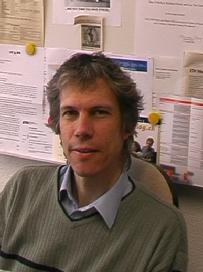|
Home
News
People
Research
Publications
Courses
Seminars
Data & Code
Contact Us
Calendar
Other Links
|
|
|
|
Computational Symmetry: Past, Present, and Future
Speakers

|
Dr. Zygmunt Pizlo
http://www1.psych.purdue.edu/~zpizlo/
Dr. Zygmunt Pizlo is a Professor of Psychology at Purdue University.
He received his Ph.D. degree in Electronic Engineering from the
Institute of Electron Technology, Warsaw, Poland in 1982, and his Ph.D.
degree in Psychology from the University of Maryland, College Park, MD
in 1991. His research interests cover all aspects of vision, including
shape, symmetry, depth, motion, binocular, color, figure-ground
organization, 3D scene recovery, eye movements, image and video quality
assessment, speed-accuracy tradeoff, as well as human motor control and
problem solving. His psychophysical studies are always accompanied by
mathematical and computational modeling: perspective and projective
invariants, multiresolution and graph pyramids, regularization and
Bayesian methods for solving inverse problems. In 2008 he published a
book on human shape perception (MIT Press), which is the first
monograph on this subject. His research has been supported by the
National Science Foundation, Air Force Office of Scientific Research,
US Department of Defense, US Department of Energy and Hewlett-Packard
Company. He co-chaired interdisciplinary workshops on shape, on problem
solving and tutorials on shape and on psychophysics. He was the
president and the member of the executive board of the Society for
Mathematical Psychology and he is the founding editor of the Journal of
Problem Solving. He has published over 100 journal and conference
papers and book chapters.
|
| Talk Title: Perception of Symmetry by Human Beings
Abstract:
Perception of symmetry has been studied scientifically for the last
100 years, beginning with the seminal book by Mach. Mach pointed out
that mirror symmetry is perceptually more salient than translational or
rotational symmetry. Aesthetics and art provided the main motivation
for the early studies, which concentrated on perception of symmetrical
retinal images. The first use of symmetry as an a priori constraint in
visual perception was described by the Gestalt Psychologists in the
1920s and 30s. They treated symmetry as representing a simplicity
principle (Prägnanz), defined, informally, as economy of perceptual
representation. Simplicity principle was responsible in Gestalt theory
for perceptual organization, in which spatially global features took
precedence over spatially local ones. During the Cognitive Revolution
in the 1950s and 60s, symmetry was extended to the case of 3D stimuli
and shown to be responsible for the topological and metric properties
of the 3D shape percept produced by a single 2D retinal image. In the
1970s, symmetry perception was again studied separately from shape. The
effect of retinal position, orientation, skew, as well as the effect of
the amount of noise was tested in a set of parametric studies. The
adoption of an inverse problem approach to vision, in conjunction with
the progress in regularization and Bayesian methods for solving
ill-posed inverse problems, brought, for the second time in history,
symmetry and shape studies together. This research included the role of
parts (geons) in perception of 3D objects, the application of Curie
principle to shape perception, the relation between symmetry and
binocular vision, and the dependence of symmetry constraint on other
constraints, namely compactness, planarity and the non-degenerate view
assumption. The tutorial will be concluded with a new definition of
shape based on the concept of symmetry.
|

|
Dr. Luc Van Gool
https://securewww.esat.kuleuven.be/psi/visics/people/?uid=1
and http://www.vision.ee.ethz.ch/members/get_member.cgi?lang=en&id=1
Luc Van Gool graduated in 82 as an electrical engineer at the
University of Leuven in Belgium. He earned a PhD on invariants of
planar contours. He is a full professor at both the University of
Leuven and the ETH Zurich in Switzerland. He leads research groups
working on computer vision at both universities. He is the co-founder
of several spin-offs, namely Eyetronics, eSaturnus, kooaba,
GeoAutomation, and Procedural.
|
| Talk Title: Symmetry Groups and their Invariants
Abstract:
Symmetric shapes, even when looked at obliquely, have invariants
that irregular shapes do not have. So-called fixed structures play a
key role in this. These are structures such as points or lines that
remain fixed under the transformation expressing the symmetry. Under
general perspective projection and for planar shapes, the fixed
structures yield subgroups of the plane projectivities. We analyse some
of the more interesting cases and derive example invariants for
each.
|

|
Dr. Sven Dickinson
http://www.cs.toronto.edu/~sven/
Sven Dickinson received the B.A.Sc. degree in Systems Design
Engineering from the University of Waterloo, in 1983, and the M.S. and
Ph.D. degrees in Computer Science from the University of Maryland, in
1988 and 1991, respectively. He is currently Professor and Chair of the
Department of Computer Science at the University of Toronto, where he
has also served as Acting Chair (2008-2009), Vice Chair (2003-2006),
and Associate Professor (2000-2007). From 1995-2000, he was an
Assistant Professor of Computer Science at Rutgers University, where he
also held a joint appointment in the Rutgers Center for Cognitive
Science (RuCCS) and membership in the Center for Discrete Mathematics
and Theoretical Computer Science (DIMACS). From 1994-1995, he was a
Research Assistant Professor in the Rutgers Center for Cognitive
Science, and from 1991-1994, a Research Associate at the Artificial
Intelligence Laboratory, University of Toronto. He has held
affiliations with the MIT Media Laboratory (Visiting Scientist,
1992-1994), the University of Toronto (Visiting Assistant Professor,
1994-1997), and the Computer Vision Laboratory of the Center for
Automation Research at the University of Maryland (Assistant Research
Scientist, 1993-1994, Visiting Assistant Professor, 1994-1997). Prior
to his academic career, he worked in the computer vision industry,
designing image processing systems for Grinnell Systems Inc., San Jose,
CA, 1983-1984, and optical character recognition systems for DEST,
Inc., Milpitas, CA, 1984-1985.
|
| Talk Title: Symmetric Parts and their Role in Object
Recognition
Abstract:
Perceptual grouping played a prominent role in support of early
object recognition systems, which typically took an input image and a
database of shape models and identified which of the models was visible
in the image. When the database was large, local features were not
sufficiently distinctive to prune down the space of models to a
manageable number that could be verified. However, when causally
related shape features were grouped, using intermediate-level shape
priors, e.g., cotermination, symmetry, and compactness, they formed
effective shape indices and allowed databases to grow in size. In
recent years, the recognition (categorization) community has focused on
the object detection problem, in which the input image is searched for
a specific target object. Since indexing is not required to select the
target model, perceptual grouping is not required to construct a
discriminative shape index; the existence of a much stronger
object-level shape prior precludes the need for a weaker
intermediate-level shape prior. As a result, perceptual grouping
activity at our major conferences has diminished. However, there are
clear signs that the recognition community is moving from appearance
back to shape, and from detection back to unexpected object
recognition. Shape-based perceptual grouping will play a critical role
in facilitating this transition. But while causally related features
must be grouped, they also need to be abstracted before they can be
matched to categorical models. In this talk, I will focus on symmetry
as a powerful regularity for decomposing a shape into parts. I will
review a number of symmetric parts-based shape representations,
including shock graphs, bone graphs, blobs/ridges, top-points, and
medial surfaces, and show how they can support effective object
indexing and recognition. I will also discuss the extent to which these
representations provide shape abstraction, which is critical in order
to handle the within-class shape variation that's required for object
categorization.
|
[back]
|
|



